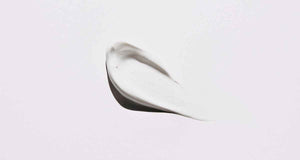We all know that moisturizing is one of the most important steps in our skincare routine, right? And if you’ve searched for the best moisturizer for you before, then you surely noticed there are two main types of moisturizers, very different from each other. It's actually quite simple to understand once you know what goes into each type of product.
But in case you ever wondered, like myself, what's the deal with so many differences in moisturizers texture and which one is better, this article will explain in-detail the difference between cream vs gel in skincare and how to choose the right texture for your skin type, skin concerns or personal preference.
Contents
What is a gel moisturizer?
Gel moisturizers are generally watery and lighter in consistency than cream moisturizers, making them a good choice for oily or acne-prone skin. They have a consistency similar to water or jelly, and they're absorbed into your skin quicker than creams. Gels can be great for oily skin since they get absorbed quickly and don't feel heavy on the skin. Gels can also help those with sensitive skin avoid irritation because they're more gentle on your face than creams are.
If you don’t like using heavy moisturizers or if you want something that absorbs into your pores quickly so you can move onto other things without waiting around for it to sink in, gels are perfect!

What is a cream moisturizer?
A cream moisturizer is a heavier, more oil-based product that gives the skin a deeper, longer-lasting hydration. This makes them suitable for dry skin types, as they can provide a protective layer against environmental damage. Creams can be more difficult to spread over the face, but they're usually better at hydrating dry skin and preventing wrinkles than gels are. The thicker consistency also means that there's less risk of too much product being applied at once, which can cause irritation.
They're also better for sensitive skin as they typically don't contain any fragrances or alcohols in them (which can irritate sensitive skin). They're also often recommended for people with mature skin.
Creams can feel a little greasy or sticky when you first apply them. You might want to let your skin absorb it a little bit before putting makeup overtop of it.
They're also more occlusive than gels and ointments, which can help prevent water loss from your skin. Creams are also more moisturizing and emollient than gels and ointments, which means they'll provide a richer protective barrier on the surface of your skin.

Gel vs. cream – key differences
I’ve briefly mentioned some differences between a gel vs cream moisturizer above, but let’s dive deeper into the subject:
- Consistency – Gel is lighter than cream; cream is heavier and it has more oil in its composition. Creams are often thought to be better suited for people with dry/aging skin because they provide more moisture than gels do (and most creams contain oils). However, if you have sensitive acne-prone skin that tends to get oily in certain seasons or climates then a gel may be better suited for you because it won't layer on top of your pores like oils might do.
- Hydration – Gel is more hydrating, but cream is more nourishing
- Application – Gel spreads more easily across the skin, while creams are emollient and will leave a residue on your face if you don't rub them in properly before applying makeup.
- Gel vs Cream Absorption – Gel moisturizers penetrate the skin more quickly, which can be good for oily or acne-prone skin types, who don't like a lot of products sitting on top of their face.
Finally, creams contain ingredients that promote healing or repair damaged skin such as antioxidants that reduce inflammation in chapped lips or eczema flare-ups; peptides that improve collagen production; niacinamide (vitamin B3) which reduces hyperpigmentation spots like age spots and freckles by increasing cell turnover rate (the process by which dead cells slough off healthy ones).
What about "cream-gel" products?
You may have noticed that your skin care products are labeled "cream-gel." This is a hybrid of the two types of formulas, and it's becoming popular because it has some of the benefits of both.
Cream-gel formulas are best for oily skin types; they're lighter than cream formulations, but thicker than hydrogel ones. The consistency is somewhere between a cream and a liquid, so they're easy to spread across your face without feeling greasy or heavy after application. They also absorb quickly into the skin without leaving behind much residue, making them ideal for those with oily or acne-prone skin who want something hydrating but still lightweight enough that it won't clog their pores.

Gel vs. cream vs. ointment – major differences
Now that you know the main differences between gels and creams in detail, what about ointments as well?
An ointment is more similar to a cream than a gel, but heavier than both of them. So, in short, creams are generally lighter than ointments, lotions and balms, but they're still richer and more moisturizing than gels.
How to choose between gel and cream moisturizers
When it comes to choosing the right product for your skin between gel and cream, there are a few questions you should ask yourself. First, you need to think about your skin type—oily or dry? Sensitive or not?
Then, you should consider your concerns like acne, wrinkles or blemishes. If you have oily skin and want something light that won't clog pores, gels might be better suited for you than creams. But if your skin is sensitive and prone to breakouts (or worse), then a cream might be the way to go with extra moisturizing ingredients packed into them.
Let's go over some of the most important factors to consider when choosing a moisturizer:
What is your texture preference?
Choosing between gel and cream based on what texture you are most comfortable with
Before getting into more complex information about skin types and skin concerns, you can first think about the texture you are most comfortable with – oftentimes, your intuition will match your skin type and needs as well.
Let’s take gel, for example – it’s light and fast-absorbing and can provide enough hydration if you don’t like your skin to feel overwhelmed with products. This means you might have oily skin that doesn’t need heavy products.
On the other hand, creams feel more luxurious on the skin than gels do—they're often thicker and contain more moisturizing ingredients like glycerin or shea butter. This makes them ideal for dry skin types who need hydration without feeling greasy.

What is your skin type?
Dry skin
Creams are more hydrating than gels. If you have dry or sensitive skin and want to keep your skin hydrated, creams may be the best option for you.
Dehydrated skin
If you have dehydrated skin, a cream moisturizer will be the way to go because it offers deeper hydration that lasts longer, with more oil in its composition.
Oily Skin
If you have normal or oily skin and you find that your face feels tight after applying some other types of skincare products (especially if you're using them regularly), consider switching over to a gel instead: they'll make your complexion look clear without causing any irritation or clogged pores! Gels are easier to absorb than creams, which means that gels are usually better for oily or acne-prone skin types.
If you tend to get pimples from time to time, you may want to consider using pimple patches. There are different types, for both deep, painful zits and surface whiteheads. These acne patches will help clear your skin a lot faster than any other regular spot treatments.
Your go-to solution kit for clearing late-stage whiteheads overnight, 72pcs
Your zit-free emergency kit for reducing early-stage painful & deep pimples, 18pcs
Mature skin
If you have combination or aging skin, consider trying both types of products in order to find what works best for different areas of your face: A gel might be great for treating oiliness around your nose while a cream would provide extra moisture where it's needed most—the cheeks and forehead area where fine lines tend to appear first.
Choosing between gel and cream based on your skin type
Consider the scenarios above and see which one of them fits you best. Here are some additional things to keep in mind:
- If you have acne-prone skin, look for a gel that is oil-free and water-based.
- What about gel vs cream sunscreen? If you are using sunscreen on your face, look for a sunscreen that is lightweight and fragrance-free.
- If your skin winds up feeling tight or dry after using moisturizer, opt for a non-comedogenic moisturizer so that it won't clog pores or cause breakouts.
Using the right moisturizer for your skin is crucial for healthy, glowing and nourished skin. Some people prefer gel, but others prefer cream. You should consider your skin type before making a decision.
For example, if you have oily skin then it’s best to use a gel-based product rather than an oil-free cream. If you have dry or sensitive skin then choose something that will hydrate without irritating or clogging pores (such as using a product with hyaluronic acid). I hope this article gave some helpful tips on choosing between gels and creams!
Hugs,
Adrienne | Co-founder of OMMA Cosmetics
Photo source: Unsplash





